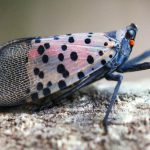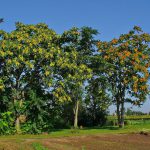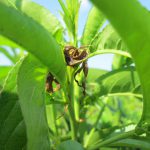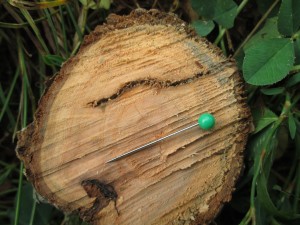Have you seen this Insect?
Some people may think it is a moth but it’s really a plant hopper known as the spotted lanternfly, Lycorma deliculata (White) and is a member of the order Hemiptera, family Fulgoridae.

Spotted Lanternfly adult. Adults are about 1″ long
Its normal distribution is in eastern Asia, China, India, and Vietnam and has been found in Japan and South Korea. The adults are large (~1” long) and quite colorful with a black head, grayish black spotted forewings and reddish black spotted hind wings.
Young juveniles are black with white spots and as they get older they become red and black with white spots.

Spotted lanterfly nymph. Nymphs are black with red markings and white dots. Do not confuse them with BMSB nymphs which do not have spots and have white banding on the antennae.
Egg masses are brownish grey and generally laid on bark in early fall and appear like a smudge of mud. Egg masses are 1-1.5” long and ½ – ¾ “ wide and survive the winter.
The spotted lanternfly is known to feed on more than 70 plant species including cultivated grapes, fruit trees, and hardwood trees. One tree of particular importance is Ailatus altissima (P. Mill) or the “Tree of Heaven”.

Tree of Heaven
Tree of Heaven typically grows in sunny areas along highways or disturbed habitat in clumps such as along farm edges. The Spotted Lanternfly must feed on Tree of Heaven to survive. Spotted Lanternfly has a sucking mouthpart and produces significant amounts of excess sugar from the plant sap, known as “honey dew”, during feeding. Honeydew can block sunlight absorption and reduce plant growth. We are concerned about this insect becoming established in New Jersey grape vineyards. In grapes, the honeydew produced during feeding is difficult to wash off and can reduce grape quality and perhaps growth. A 2015 and 2016 of 9 vineyards within southern New Jersey by the fruit entomology lab did not observe any spotted lanternfly adults or nymphs. However, in Pennsylvania, adults and nymphs were found in commercial vineyards in 2016 in Chardonnay, Concord, and Niagara plantings, although populations were low. Vineyard rows neighboring forested edges are at highest risk.

Egg mass
Additional information regarding this insect can be found at:
The Pennsylvania Department of Agriculture
If you think you seen or collected a spotted lanternfly please report it the New Jersey Department of Agriculture and the Department of Entomology at the Rutgers University School of Environmental and Biological Sciences by emailing slanternfly@njaes.rutgers.edu. This post was written by Anne L Nielsen and George C. Hamilton from the Department of Entomology.



